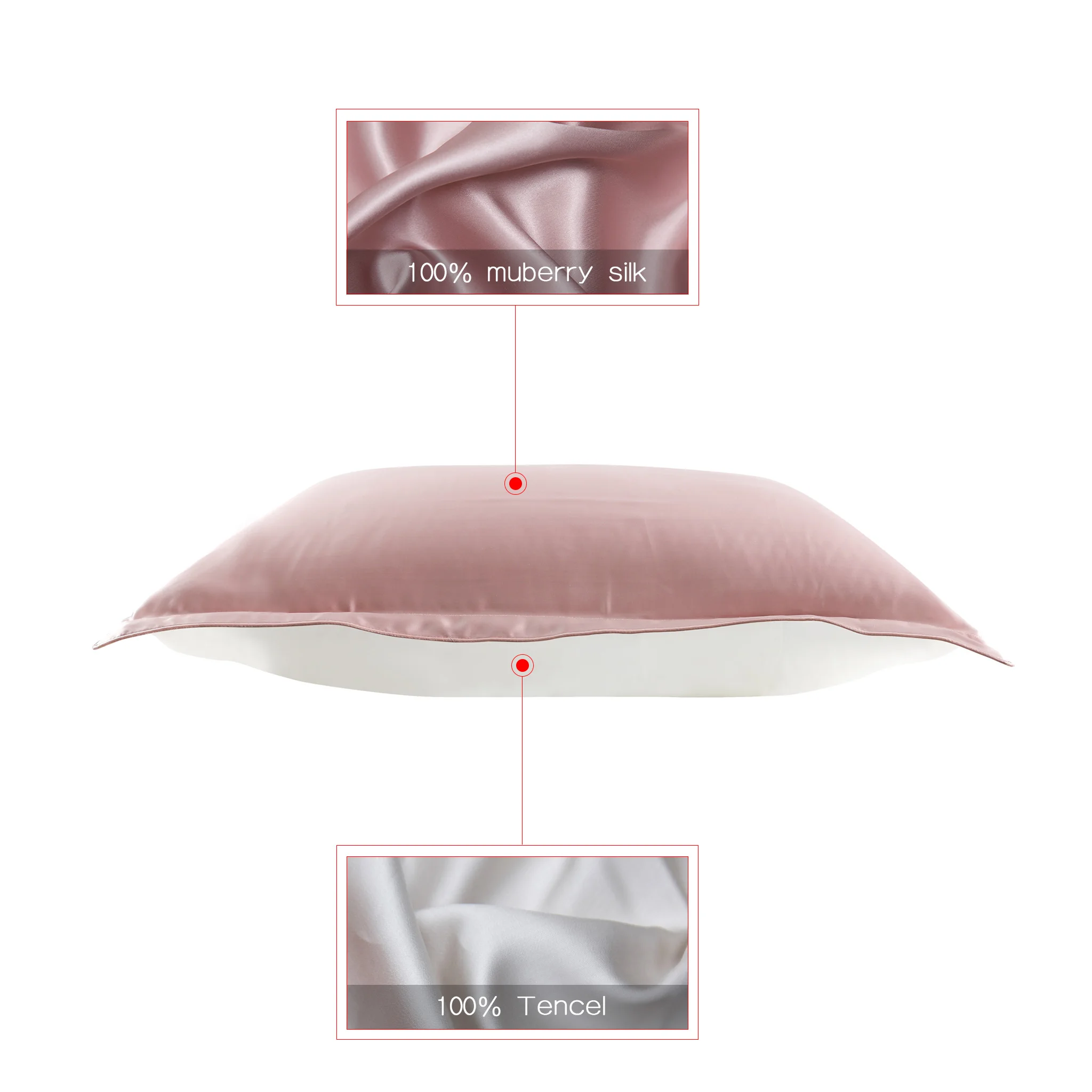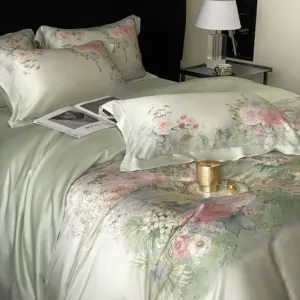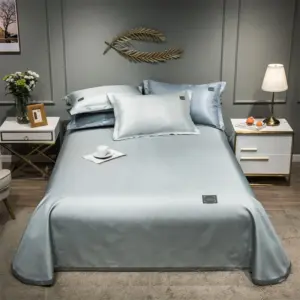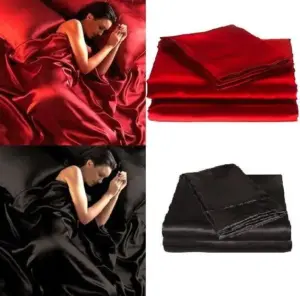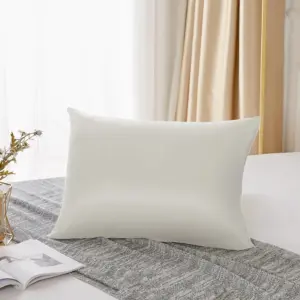Introduction: Why Your Pillowcase Choice Matters for Hair Health
Your pillowcase affects your hair health far more significantly than most people realize. This simple bedding choice, often overlooked, can be the difference between waking up with smooth, manageable hair or dealing with frizzy, damaged strands day after day.
Consider this: we spend approximately one-third of our lives sleeping, which translates to thousands of hours annually with our hair in direct contact with our pillowcases. During this time, the friction between your hair and pillowcase creates microscopic damage to the protective outer layer of your hair strands, called cuticles. Over time, this cumulative effect can lead to noticeable changes in your hair’s appearance and health.
Different pillowcase materials interact uniquely with your hair’s natural moisture, oils, and any styling products you may use. These interactions directly influence hair breakage, frizz levels, moisture retention, and how well your hairstyle holds up overnight. Understanding these effects can help you make a more informed decision about the simple yet impactful choice between silk pillowcase benefits for hair and traditional cotton options.
In this comprehensive guide, we’ll examine how silk and cotton pillowcases differently affect your hair, which material might be best for your specific hair type, and practical considerations to help you make the right choice for your hair care routine.
Understanding How Pillowcase Materials Affect Hair
A. Key Properties of Silk Pillowcases
Silk is a natural protein fiber produced by silkworm cocoons, primarily from the Bombyx mori moth species. What makes silk exceptional for hair care is its incredibly smooth, tightly woven surface structure. When examined microscopically, silk fibers have a remarkably uniform and seamless composition that creates minimal friction against hair strands.
The natural composition of silk includes 18 amino acids and a protein called sericin, which shares similarities with the proteins in human hair. This biological compatibility is part of what makes silk so beneficial for hair care. Key properties include:
- Exceptionally low friction coefficient that allows hair to glide freely across the surface
- Minimal moisture absorption (only absorbs 11% of its weight in moisture)
- Natural hypoallergenic qualities beneficial for sensitive skin and scalps
- Temperature-regulating properties that maintain optimal conditions for hair
- Natural resistance to dust mites, mold, and fungi, creating a cleaner sleep surface
- Quality measured by momme weight, with 19-25 momme providing optimal balance between luxury and durability
Mulberry silk, considered the premium variety of silk, comes from silkworms fed exclusively on mulberry leaves. This diet produces longer, more uniform silk threads that create the finest and most durable Mulberry silk pillowcases available, with exceptional smoothness that benefits hair significantly.
B. Key Properties of Cotton Pillowcases
Cotton is a natural plant-derived fiber harvested from the seedpods of cotton plants. Unlike silk’s smooth protein structure, cotton has a more porous and rougher fiber makeup, even in high-quality varieties. This fundamental difference in structure creates distinct interactions with your hair.
Cotton’s key properties include:
- High absorbency (can absorb up to 27% of its weight in moisture)
- Stronger moisture-wicking capabilities that pull moisture away from hair
- Various weave options affecting texture (percale is crisp and cool; sateen is softer and warmer)
- Excellent breathability allowing air circulation
- Thread count variation (200-800+ being common) that affects smoothness and durability
- Greater durability with proper care, often lasting many years
- Machine washable and generally easier to maintain than silk
The comparison between silk and cotton pillowcases reveals fundamentally different material characteristics. While cotton’s absorbency makes it excellent for certain applications, this same property can potentially disrupt hair’s moisture balance. Higher thread counts in cotton can improve smoothness, but even the highest quality cotton still has a fundamentally different interaction with hair than silk does.
Direct Comparison: How Silk and Cotton Affect Your Hair
A. Friction and Breakage Impact
Silk Effects:
Silk’s primary benefit for hair comes from its incredibly smooth surface that creates minimal friction against hair strands. When you move during sleep (the average person changes positions 20-40 times per night), your hair glides effortlessly across silk rather than catching or dragging. This reduced friction prevents the hair cuticle—the protective outer layer of each strand—from being roughened and damaged.
For hair that’s already vulnerable from chemical processing, coloring, or heat styling, this friction reduction is particularly valuable. The gentler surface prevents further mechanical stress on already compromised strands, helping maintain structural integrity and reducing the occurrence of split ends and mid-shaft breaks in the hair.
Cotton Effects:
Cotton, even high-quality varieties, has a rougher surface at the microscopic level. This creates noticeable friction as hair moves across it during sleep. This friction physically disturbs the hair cuticle, lifting these protective scales and exposing the more vulnerable inner cortex of the hair shaft to damage.
The rougher texture of cotton can catch and pull on hair strands, creating tension points that eventually lead to breakage. This effect is particularly problematic for dry, processed, or already damaged hair where the cuticle may already be compromised. Over time, this consistent friction contributes significantly to split ends and breakage, especially for those who move frequently during sleep.
The mechanisms behind how silk pillowcases reduce hair breakage are well-established in the hair care community, with the dramatic reduction in friction being the primary factor in preserving hair integrity during sleep.
B. Moisture Retention and Hair Hydration
Silk Effects:
Silk has natural hydrophobic (water-repelling) properties that prevent it from absorbing significant moisture from your hair while you sleep. This characteristic allows hair to retain its natural oils and moisture balance, which is crucial for maintaining healthy, hydrated strands.
When you apply leave-in conditioners, serums, or hair oils before bed, silk allows these products to remain in your hair rather than being absorbed into your pillowcase. This extended contact time maximizes the benefits of your hair care products.
These moisture-preserving qualities are especially beneficial for naturally dry, curly, or textured hair types that already struggle with moisture retention. By helping maintain optimal hydration levels, silk pillowcases contribute to increased hair elasticity and reduced breakage potential.
Cotton Effects:
Cotton’s highly absorbent nature means it readily wicks away moisture from anything it contacts—including your hair. While this makes cotton excellent for items like towels, it creates a significant disadvantage for hair health during the 7-8 hours of nightly contact.
This absorption pulls natural oils and moisture from hair shafts, potentially leaving strands dehydrated by morning. Similarly, any beneficial hair treatments applied before sleep can be partially absorbed by cotton pillowcases rather than fully benefiting your hair.
The moisture loss from cotton contact can be particularly problematic for already dry or damaged hair types, potentially exacerbating issues like frizz, brittleness, and decreased elasticity that lead to breakage.
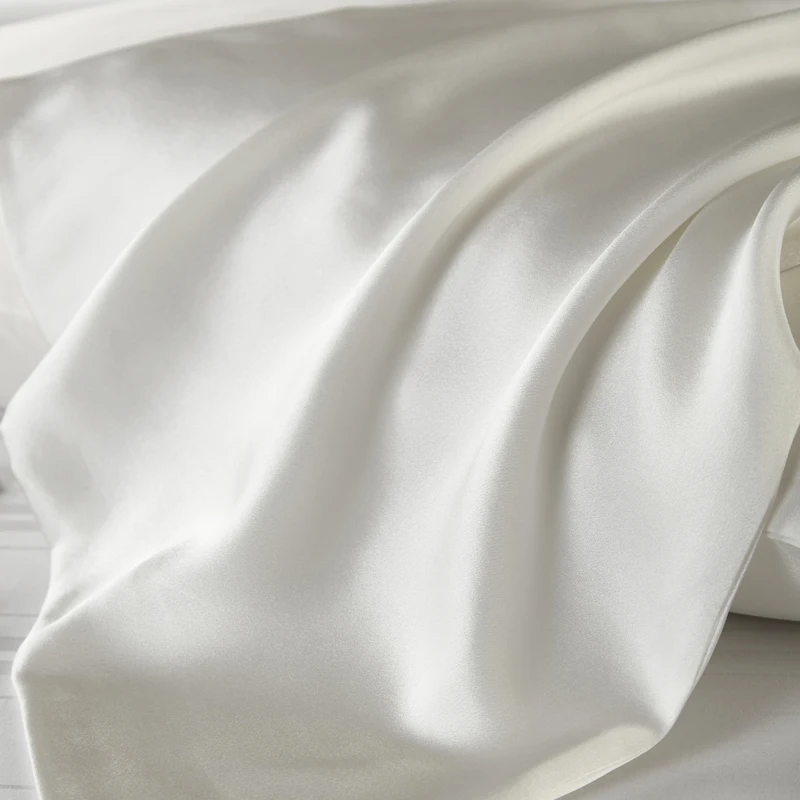
Our collection of premium silk pillowcases offers exceptional moisture retention benefits that can transform hair health with consistent use.
C. Frizz Control and Hair Smoothness
Silk Effects:
• Silk’s smooth surface helps keep hair cuticles flat and properly aligned, maintaining the hair’s natural smooth appearance
• Minimal friction during sleep movements prevents the cuticle disruption that creates frizz
• Natural properties in silk reduce static electricity buildup in hair
• Helps maintain hair’s natural alignment and smoothness throughout the night
• Results in visibly reduced frizz both immediately and with continued use over time
Cotton Effects:
• Cotton’s textured surface can disturb and lift hair cuticles during sleep movements
• The resulting friction creates raised, misaligned cuticles—the primary cause of frizz
• Cotton can generate significant static electricity, particularly in dry environments
• Morning “bed head” is often more pronounced with cotton pillowcases
• May require additional styling time and products to smooth hair after sleeping on cotton
The benefits of silk pillowcases for curly hair care are particularly notable, as curly hair types are naturally more prone to frizz due to their structure. The smooth silk surface helps curly hair maintain definition and reduces the disruption of curl patterns during sleep.
D. Hairstyle Preservation and Longevity
Silk Effects:
Silk allows hair to glide across the surface without creating the tension or friction that disturbs carefully styled hair. This preservation quality is particularly beneficial for:
– Curls and waves, which maintain their definition rather than being flattened or disrupted
– Blowouts and straight styles, which experience less frizz and maintain smoothness longer
– Braided styles, which encounter less friction that could cause fuzziness or unraveling
– Professionally styled hair, helping extend the life of salon services by several days
The smooth surface also helps maintain more even distribution of styling products throughout the night, rather than having them absorbed or redistributed unevenly due to friction.
Cotton Effects:
Cotton’s texture and grip tend to disrupt hairstyles during sleep movements. This disruption commonly results in:
– Flattened curls that lose definition and volume
– Waves that become inconsistent or partially straightened
– Straight styles developing kinks, dents, or directional inconsistencies
– Increased frizz that compromises the overall finish of any style
These style disruptions typically require daily restyling, often involving heat tools that contribute to long-term damage when used regularly. The additional manipulation required to restore styles also increases mechanical stress on hair.
E. Effect on Scalp Health and Oil Balance
Silk Effects:
Silk’s non-absorbent nature helps maintain your scalp’s natural oil balance rather than stripping away essential sebum. This preservation of natural oils allows them to distribute properly through hair shafts, providing natural conditioning.
The smooth texture reduces pulling and irritation on the scalp, which can be especially beneficial for sensitive scalps or those with conditions like eczema or psoriasis. Additionally, silk’s natural properties mean less transfer of facial products to the hairline and scalp, reducing potential irritation from ingredients not intended for the scalp.
Cotton Effects:
Cotton’s high absorbency can strip away scalp oils, potentially triggering increased oil production as the body attempts to compensate for the loss. This cycle can lead to oilier roots for some individuals, particularly those with already active sebaceous glands.
The rougher texture may cause more friction against the scalp, potentially exacerbating sensitivity or irritation for those with scalp concerns. Furthermore, cotton’s moisture retention can create a more hospitable environment for bacteria growth, potentially impacting scalp health over time.
Understanding these differences helps explain why many people report improvements in both hair and scalp condition when switching to transformative silk pillowcases for hair health.
Beyond Hair: Additional Considerations When Choosing Pillowcases
A. Skin Benefits and Considerations
The choice between silk and cotton pillowcases affects not only your hair but also your facial skin. Silk’s smooth surface creates less friction against facial skin, potentially reducing the formation of sleep creases and minimizing irritation for sensitive skin types.
The lower absorption rate of silk means that expensive facial moisturizers and treatments remain on your skin rather than being absorbed by your pillowcase. This allows skincare products to work more effectively throughout the night.
Silk’s natural hypoallergenic properties can be beneficial for those with sensitive skin conditions or allergies. The protein structure of silk is less likely to trigger skin reactions than some other fabrics.
Since hair and skin health are interconnected, the benefits of a silk pillowcase extend beyond aesthetics to overall wellness, creating a comprehensive approach to overnight beauty care.
B. Durability, Maintenance and Care Requirements
Silk Care:
* Wash silk pillowcases in cold or lukewarm water using mild, silk-specific detergent
* Use gentle cycle or hand wash to prevent fiber damage
* Avoid bleach, fabric softeners, or harsh chemicals that can damage silk proteins
* Air dry away from direct sunlight, or use dryer on lowest heat setting
* Iron on low heat if needed, using a pressing cloth between iron and silk
* With proper care, quality silk pillowcases typically last 2-3 years
Cotton Care:
* Machine washable in warm water with standard detergents
* Can withstand more vigorous washing and higher temperatures
* May be tumble dried on medium to high heat
* Relatively resistant to most cleaning products, including bleach for white cotton
* Higher thread count cotton may require more gentle handling for longevity
* Typically maintains integrity through hundreds of washes over 3-5 years
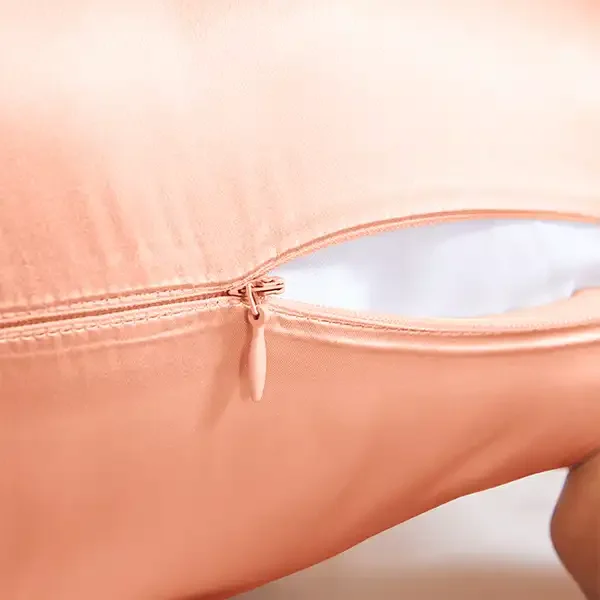
Proper care is essential for maintaining the hair benefits of any pillowcase, but particularly for standard size silk pillowcases, which require more specific maintenance to preserve their beneficial properties.
C. Cost Considerations and Value Assessment
When evaluating silk versus cotton pillowcases, cost differences must be considered alongside long-term value. Quality silk pillowcases typically range from $50 to $150, with premium options from brands like Sanctuary Soft often positioned at the higher end of this spectrum due to superior silk quality and craftsmanship.
Several factors affect silk pricing, including:
– Momme weight (19-25 momme offering optimal balance)
– Silk grade (6A being the highest quality)
– Manufacturing processes and finishing techniques
– Brand reputation and quality control
While cotton pillowcases generally cost between $5 and $40, calculating cost-per-use often reveals silk as a worthwhile investment for those prioritizing hair health. When considering reduced need for styling products, heat styling, and potential damage repair treatments, many users find the initial investment in silk justified by the long-term savings and hair health benefits.
For those exploring options across price points, understanding the quality metrics differentiating cotton and silk helps make an informed decision aligned with both budget and hair care priorities.
Eucalyptus Silk Bedding Sets, Eucalyptus Silk Sheets
Price range: $360.24 through $393.60 Select options This product has multiple variants. The options may be chosen on the product page- Price range: $267.82 through $306.55 Select options This product has multiple variants. The options may be chosen on the product page
Bamboo Silk Sheets, Cooling Silk Sheets
Price range: $130.76 through $177.80 Select options This product has multiple variants. The options may be chosen on the product pageBamboo Silk Sheets, Queen Size Silk Fitted Sheet
Price range: $230.24 through $297.88 Select options This product has multiple variants. The options may be chosen on the product pageKing Size Silk Pillowcases, Mulberry Silk Pillowcases, Queen Size Silk Pillowcases
Price range: $94.96 through $121.56 Select options This product has multiple variants. The options may be chosen on the product page- 100% Bamboo Fiber Parrot Duvet Cover Set – Queen King Twin Size Tropical Bedding for Comfort & StylePrice range: $241.95 through $380.95 Select options This product has multiple variants. The options may be chosen on the product page
Making the Right Choice for Your Hair Type
A. Recommendations for Different Hair Types and Concerns
For Curly/Textured Hair:
Silk pillowcases offer exceptional benefits for curly and textured hair types. The minimal friction helps maintain curl definition and pattern integrity overnight, while the moisture-preserving properties support the higher hydration needs of curly hair.
For maximum benefit, opt for higher momme weight silk (22-25) that provides optimal smoothness and durability. Individuals with particularly defined curl patterns or coily hair may notice the most dramatic improvements, with reduced frizz, maintained definition, and decreased need for morning restyling.
For Fine/Fragile Hair:
Fine or fragile hair benefits significantly from silk’s reduced friction. The gentle surface minimizes the mechanical stress that can lead to breakage in delicate strands. Those with thinning hair or damage from chemical processing will particularly appreciate silk’s protective qualities.
For chemically treated, colored, or heat-damaged hair, silk helps preserve integrity by reducing further stress on already compromised strands. This protection can extend the time between salon visits and reduce the appearance of split ends.
For Oily Hair:
Contrary to some misconceptions, silk can actually help regulate oil production for those with oilier hair types. By not stripping away natural oils as aggressively as cotton, silk helps maintain a more balanced scalp environment that may reduce the overproduction of sebum over time.
For best results, those with oily hair should wash silk pillowcases slightly more frequently (every 3-5 days) and ensure proper washing to remove oil buildup that could transfer back to hair.
For Color-Treated Hair:
Silk provides valuable protection for color-treated hair by reducing the friction that can fade color molecules from the hair shaft. The reduced absorption also helps preserve specialized color-depositing conditioners or treatments used overnight.
Reduced moisture loss helps maintain the integrity of colored hair, which is often more porous and prone to damage, extending the vibrancy and life of color treatments between salon visits.
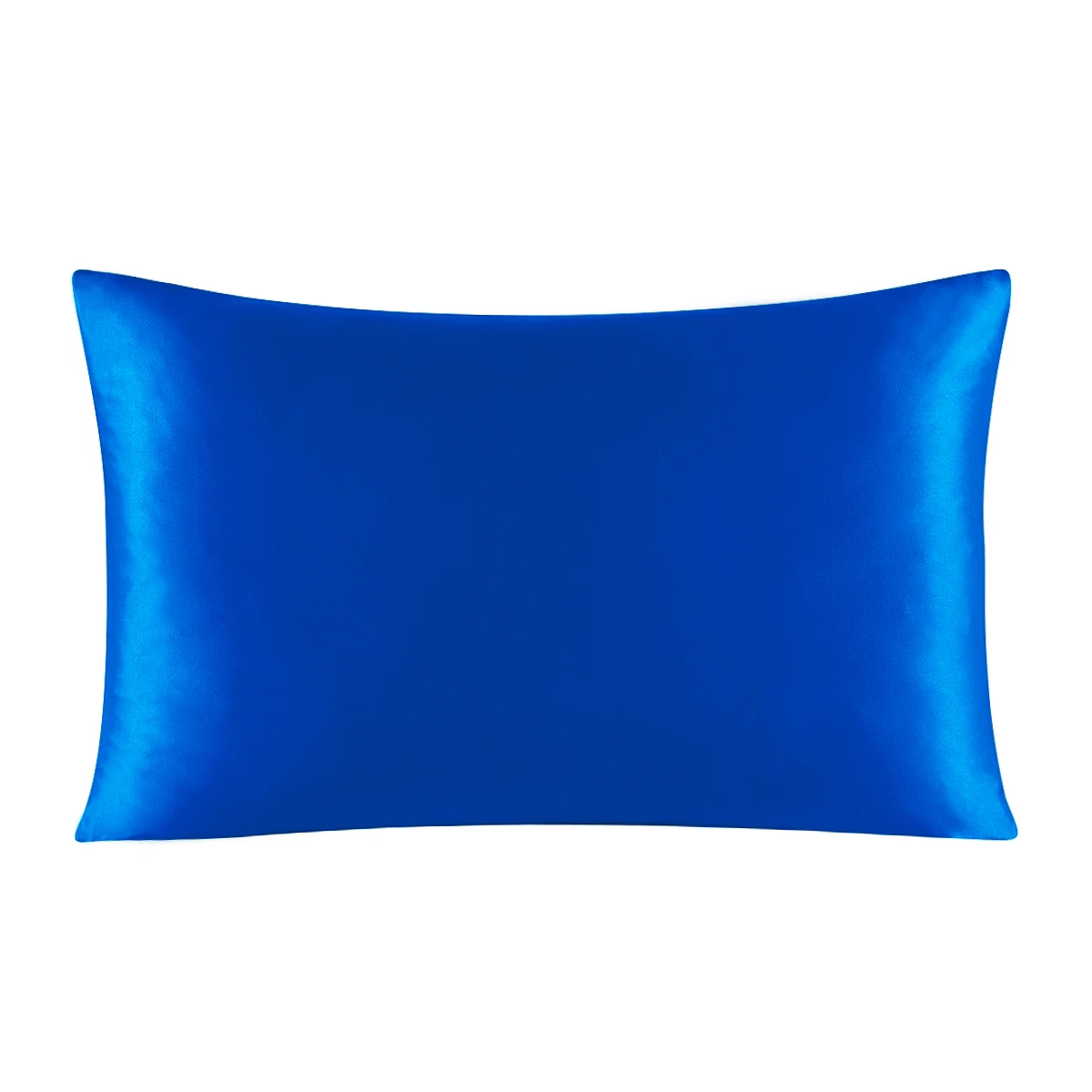
Understanding which pillowcase materials promote healthy hair for your specific type can transform your hair care routine with minimal effort.
B. When Cotton Might Be Preferable
While silk offers numerous advantages for hair health, certain situations might make cotton pillowcases a preferable choice for some individuals. Those with extremely oily scalps who benefit from cotton’s absorption properties may prefer cotton, particularly when dealing with excess oil production that leads to flat, limp hair.
Budget considerations can also make high-quality cotton a reasonable alternative, especially when comparing luxury cotton options to lower-quality silk. In these cases, a high thread count (400+) cotton pillowcase can provide a smoother surface than standard options.
Seasonal preferences may influence choices as well, with some users preferring cotton’s cooling properties during warmer months. A practical compromise for those concerned about both budget and hair care is using cotton pillowcases with a silk scarf or bonnet specifically protecting the hair.
Frequently Asked Questions About Pillowcases and Hair
Is satin as good as silk for hair benefits?
Satin provides some similar benefits to silk but typically doesn’t perform quite as well. As a weave rather than a fiber, satin can be made from various materials including polyester. While satin offers reduced friction compared to cotton, natural silk provides superior smoothness and moisture retention benefits for hair. Satin can be a budget-friendly alternative that delivers partial benefits.
How often should I wash my silk pillowcase to maintain benefits?
For optimal hair benefits, wash silk pillowcases every 7-10 days, or more frequently if you apply hair products before bed or have oily hair. Regular washing prevents product buildup and oil accumulation that could transfer back to your hair and skin.
Can changing my pillowcase really reduce hair breakage significantly?
Yes, many users report noticeable reduction in breakage after switching to silk. Studies show that friction is a major cause of mechanical damage to hair, and silk’s smooth surface significantly reduces this friction. Those with fragile, processed, or curly hair typically notice the most dramatic improvements.
Do silk pillowcases actually help with hair growth?
Silk pillowcases don’t directly stimulate hair growth, but they can create conditions that support healthier growth. By reducing breakage and protecting existing hair, silk pillowcases help you retain length that would otherwise be lost to damage, giving the appearance of faster growth.
Are there different grades of silk that matter for hair protection?
Yes, silk quality varies significantly. Mulberry silk is considered the highest quality, with momme weight (similar to thread count) being the key indicator. For hair benefits, look for 19-25 momme silk, which provides the optimal balance of smoothness, durability, and moisture-wicking properties.
How quickly will I notice a difference in my hair after switching to silk?
Many people notice immediate differences like reduced morning frizz and better style preservation after just one night. More significant benefits like reduced breakage and improved overall hair health typically become apparent after 2-4 weeks of consistent use.
Exploring whether silk pillowcases truly help improve hair health reveals compelling evidence supporting their benefits across multiple hair types and concerns.
Silk Alternatives: Other Hair-Friendly Pillowcase Options
For those seeking alternatives to traditional silk, several options provide varying degrees of hair benefits. Satin pillowcases, made from polyester, nylon, or blended materials, offer a more affordable alternative with some similar properties to silk. While they provide reduced friction compared to cotton, they typically don’t match silk’s moisture retention or protein structure benefits.
Bamboo pillowcases have gained popularity as an eco-friendly option with a relatively smooth surface. While not as frictionless as silk, bamboo’s natural properties offer better moisture management than cotton and a smoother surface that reduces some friction issues.
Some specialty fabrics marketed specifically for hair care combine synthetic materials designed to mimic silk’s properties at lower price points. These vary considerably in effectiveness but can provide a middle ground between cotton and true silk.
For those concerned about traditional silk production methods, vegan silk bedding alternatives offer similar benefits using cruelty-free manufacturing processes, making them an excellent choice for the ethically conscious consumer who still prioritizes hair health.
When selecting any alternative, focus on smoothness, moisture retention properties, and reduced friction as the key factors that will most directly benefit your hair’s health and appearance.

